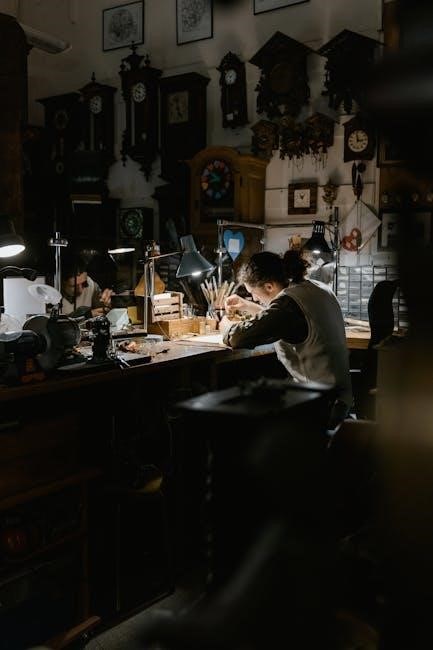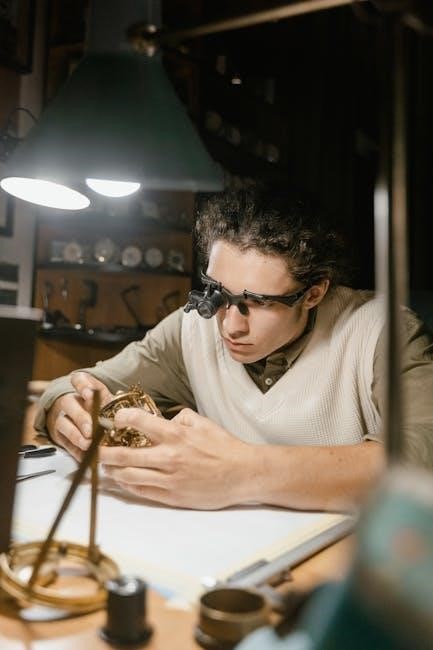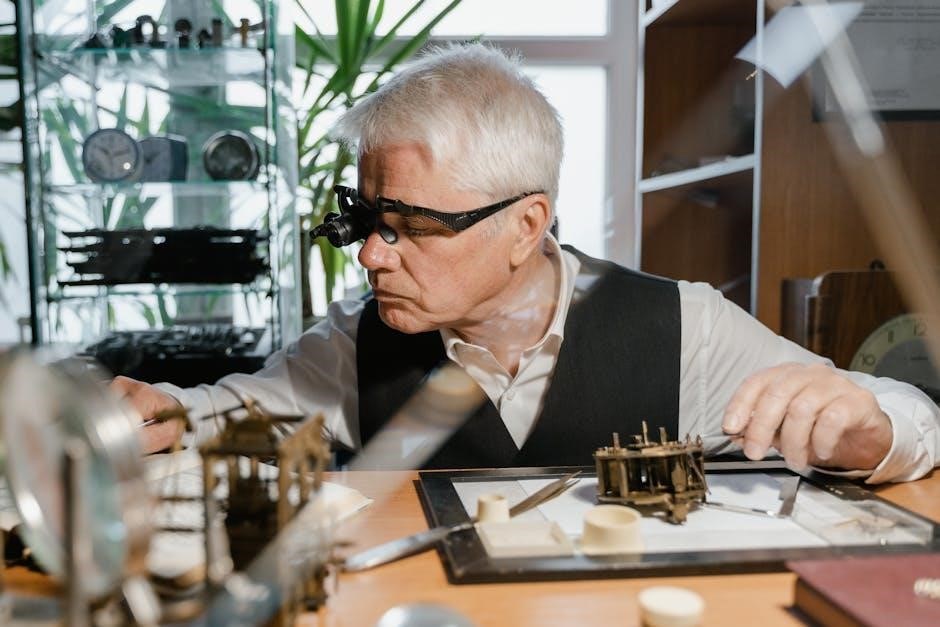Cuckoo Clock Repair Manual PDF: An Overview
Discovering the world of cuckoo clock restoration becomes easier with accessible PDF repair manuals. These guides provide comprehensive instructions, diagrams, and photos, assisting enthusiasts in understanding their clock’s mechanics, and enabling confident repair attempts.

Common Cuckoo Clock Problems
Cuckoo clocks, while charming, encounter common issues. These may include a malfunctioning cuckoo call, inaccurate timekeeping, or complete stoppage. Identifying these problems is the first step, and a good repair manual helps diagnose and resolve them effectively.
Identifying Issues: Cuckoo Call, Timekeeping, and Movement
Pinpointing problems in a cuckoo clock requires a systematic approach. Start by assessing the cuckoo call: Is it absent, weak, or distorted? Next, examine the timekeeping accuracy. Is the clock running too fast, too slow, or stopping altogether? These indicate potential issues within the movement.
A silent cuckoo could stem from bellows issues, obstructions, or a disengaged mechanism. Erratic timekeeping often points to dirty gears, a need for oiling, or worn components. Complete stoppage frequently signals accumulated dust, hardened oil, or broken parts preventing smooth operation.
Carefully observe the clock’s movement. Are the weights descending evenly? Do the gears appear to be turning freely? Listen for unusual noises like grinding or clicking, which can help narrow down the source of trouble. Thorough inspection aids in targeted repairs.
Consulting a repair manual with detailed diagrams and troubleshooting advice is invaluable for accurate diagnosis and effective solutions.
Essential Tools for Cuckoo Clock Repair
Successful cuckoo clock repair hinges on having the right tools. A set of precision screwdrivers, including various sizes of flathead and Phillips head, is crucial for disassembling and reassembling delicate components. Tweezers, both pointed and flat-tipped, aid in handling small parts and springs without damage.
Clock oil, specifically formulated for clock movements, ensures smooth operation and prevents wear. A small oiler with a fine tip allows for precise application. Cleaning solutions, such as denatured alcohol or specialized clock cleaning fluids, are essential for removing dirt and old oil.
Magnifying glasses or a jeweler’s loupe help in examining tiny parts for wear or damage. A soft brush, like a paintbrush or toothbrush, assists in cleaning dust from gears and other components. Finally, having a well-lit workspace is fundamental for careful work. These tools enable accurate and safe repairs.
Consult a trusted cuckoo clock repair manual PDF for guidance on proper usage.

Step-by-Step Repair Guides Available in PDF Format
Accessible PDF guides offer detailed, step-by-step instructions for cuckoo clock repair. They often feature diagrams, photos, and troubleshooting tips, making the repair process easier to understand and execute successfully.
“The Cuckoo Clock Owner’s Repair Manual” by D. Rod Lloyd
D; Rod Lloyd’s “The Cuckoo Clock Owner’s Repair Manual” stands out as a comprehensive and updated guide for cuckoo clock owners. This manual offers a step-by-step approach, making it accessible even for those with no prior clock repair experience.
The book boasts hundreds of color photos and diagrams, providing clear visual aids throughout the repair process. Dedicated specifically to cuckoo clocks, the updated 2023 edition ensures that readers have access to the most current information and techniques.
The manual covers a wide range of topics, including movement identification (Regula, Baduf, Hubert Herr, Schatz), cleaning and oiling, and complete step-by-step repair procedures. Whether your clock is a family heirloom or a recent gift, this manual equips you with the knowledge to tackle common issues.
Available in PDF format for instant download, it allows users to zoom in on details, translate the text, and even print sections as needed; A printed version can also be found on Amazon for those who prefer a physical copy.
“Cuckoo Clock Repair Made Simple” by Tom Seaman
Tom Seaman’s “Cuckoo Clock Repair Made Simple” offers a focused approach to repairing cuckoo clocks, particularly those featuring the one-day Regula 25 movement. Published in 2007, this book provides clear instruction in the intricacies of cuckoo clock repair.
While the manual may not be as visually rich as some of the more recent publications, its straightforward language and step-by-step guidance make it a valuable resource for beginners. The book’s emphasis on the Regula 25 movement allows for a deeper understanding of this common mechanism.
Available in PDF, EPUB, and Kindle formats, “Cuckoo Clock Repair Made Simple” provides accessibility across various devices. Although the book may not cover every possible cuckoo clock model or issue, it serves as an excellent starting point for those looking to learn the fundamentals of cuckoo clock repair.
Whether you’re dealing with a non-functioning cuckoo call or timekeeping problems, Seaman’s manual offers practical advice and troubleshooting tips to get your clock back in working order.

Cleaning and Oiling the Movement
Cleaning and oiling the movement are essential steps in cuckoo clock maintenance and repair. Over time, dust and old oil can accumulate, causing the clock to slow down or stop working altogether. Before cleaning, dismantling the movement is necessary to access all the components.
Carefully remove each part, noting its position for reassembly; Use specialized clock cleaning solutions to dissolve dirt and grime. After cleaning, thoroughly dry each component before applying fresh clock oil to the pivots and gears. Proper lubrication reduces friction and ensures smooth operation.
The type of oil used is crucial; use only high-quality clock oil designed for delicate mechanisms. Avoid using household oils, as they can damage the clock. Reassemble the movement with care, ensuring each part is correctly positioned. After reassembly, test the clock to ensure it runs smoothly and accurately.
Regular cleaning and oiling, every few years, can significantly extend the life of your cuckoo clock and maintain its performance. Neglecting this can lead to costly repairs or permanent damage.
Troubleshooting Specific Issues
Addressing specific issues in cuckoo clocks requires a systematic approach. This involves identifying the problem, understanding its cause, and implementing targeted solutions, often guided by detailed repair manuals and expert advice.
Addressing Problems with the Cuckoo Call
When a cuckoo clock’s signature call goes silent or sounds off-key, troubleshooting becomes necessary. Several factors can contribute to this issue, ranging from simple fixes to more complex repairs. Firstly, check the night-off handle, as it might be engaged, preventing the cuckoo from calling. This handle is usually located underneath the clock or on its side.
Next, inspect the bellows, which are responsible for producing the cuckoo sound. Damage or leaks in the bellows can significantly affect the call’s quality or silence it altogether. Also, verify the windpipe’s condition, ensuring it’s free from obstructions. If the cuckoo bird itself is dirty or stuck, it may need gentle cleaning or adjustment to move freely.
For more intricate problems, refer to a detailed repair manual such as “The Cuckoo Clock Owner’s Repair Manual” by D. Rod Lloyd, which provides step-by-step instructions and diagrams. Remember, patience and careful observation are key when dealing with delicate clock mechanisms.

Finding Professional Repair Services
While repair manuals offer valuable guidance, some cuckoo clock issues require expert attention. Locating a qualified professional ensures the intricate mechanisms are handled with care and precision. Start by seeking recommendations from local clock shops or online horological forums. Check for repair services specializing in cuckoo clocks, as expertise varies among clockmakers.
Before entrusting your clock, inquire about the repairer’s experience, certifications, and customer reviews. A reputable service should offer a detailed assessment, transparent pricing, and a warranty for their work. Be wary of unsolicited offers or demands for upfront payments without a thorough inspection. Consider reaching out to service stations recommended by clock manufacturers, although they might prioritize clocks they originally sold.
Remember to call in advance and describe the problem you’re experiencing. Professional repair services can restore your cherished cuckoo clock to its former glory, preserving its value and functionality for years to come.
Maintaining Your Cuckoo Clock
Consistent maintenance is vital for preserving the longevity and accuracy of your cuckoo clock. Regularly dust the exterior with a soft cloth to prevent grime buildup. Check the chains and weights for any signs of wear or damage, replacing them as needed to ensure proper function. Address any issues like a stopping clock promptly, as this could signal a need for cleaning and oiling.
Consider professional servicing every few years to thoroughly clean and lubricate the movement, preventing excessive wear on the delicate components; Proper oiling is crucial, as dry metal parts can grind against each other, causing significant damage. Avoid placing your clock in direct sunlight or humid environments, as these conditions can affect the wood and metal.
By following these simple guidelines, you can keep your cuckoo clock ticking smoothly and preserve its charm for generations. Remember that preventative care is always more cost-effective than extensive repairs.
